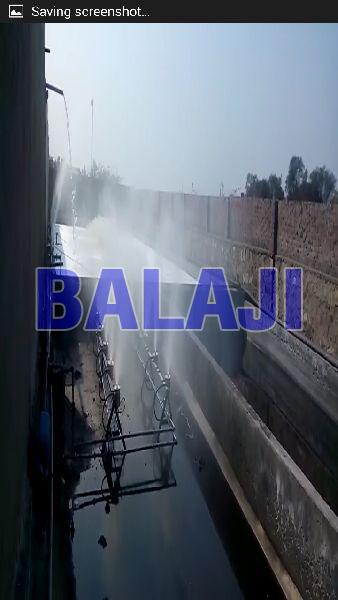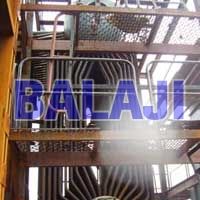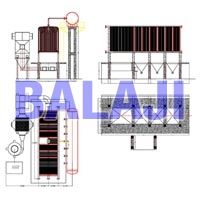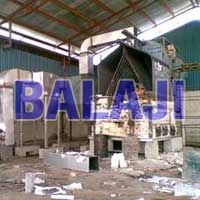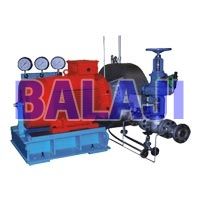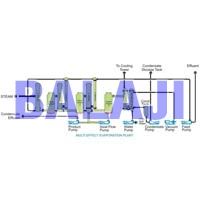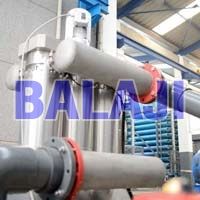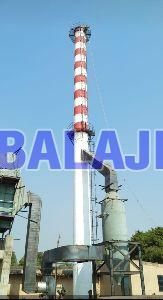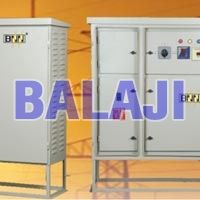| Business Type | Manufacturer, Exporter, Supplier, Retailer |
| Type | Air Diffuser Type |
| Condition | New |
| Brand Name | Braj Projects Pvt.Ltd. |
| Click to view more | |
Product Details
We are amidst the dependable Manufacturers, Exporters and Suppliers of the Zero Discharge System. The Zero Discharge System evaporates water from Pretreated Effluent in almost the same way as thermal evaporators, employing the principle of diffusion at normal temperature.
To recapitulate the basic aspects of the novel design :
- Braj Projects Pvt.Ltd. design basically differs from conventional evaporators in the underlying principle; the former uses heat to evaporate water, whereas the later (Braj Projects Pvt.Ltd.'s design) employs the natural phenomenon of diffusion of water which does not require heat.
- The natural process of diffusion is as such slow, but can be greatly enhanced by, large inter facial area between air and water, turbulence, finer particle size of water and large air to water ratio.
- It has been proven scientifically in the highly reputed universities and renowned institutions in the West that at sub-micron size of the water particles in the normal atmosphere, the natural process of evaporation, called diffusional evaporation, ensures that it is completely vaporizes before it hits the ground, if released at sufficient height.
- In order to utilize this well-proven principle for practical and effective evaporation of effluent into water in the atmosphere, the effluent has to be adequately stripped off all its dissolved organic and inorganic contents beforehand, besides removal of turbidity, suspended solids etc.
- This process of natural evaporation would be dependent on the atmospheric conditions like humidity, wind speed, temperature etc and therefore should be harnessed and designed for the adverse combinations of governing parameters so that at all other time higher evaporation would occur.
- Braj Projects Pvt.Ltd. does not claim that it has Invented Natural Evaporation By Diffusion, but it does claim that it has harnessed this principle for practical, effective evaporation of effluent into water by perhaps more user-friendly method suitable for the Indian conditions
With above background, it becomes clear that the effluent has to be properly pretreated before it is pumped into Braj Projects Pvt.Ltd.'s ZDS involving; equalization, pH control, removal of volatile organics, removal of suspended solids and turbidity, and lastly adequate removal of dissolved impurities.
There are basically two types of dissolved impurities in the effluent, organic and inorganic, manifesting themselves as COD, BOD,TOC, etc. and TDS. Firstly, the effluent has to be passed through a packed bed of activated carbon, granular form, with app surface area about 80-100sq meter per gram. It is well known that activated carbon of good quality possesses extremely good adsorptive for most of the organic impurities present in the textile effluents. Therefore, after passage thru carbon bed ,most of the dissolved organics of the effluent would be removed, with optimum contact time and sufficient depth of the bed, say,.5m to 1.0meter and dia of about 0.5 to 0.75m.The carbon bed as usual would have distributors, supporting plate, mild steel shell, inlet and outlet and so on.
After removal of organics in the carbon bed of adequate quantity, the effluent is passed through a mixed bed of anionic and cationic resins which are well known to remove inorganic salts from the effluent by the ion exchange process. This would be also made from mild steel shell lined with epoxy to withstand corrosion by the effluent. It would be a packed bed with usual connections like inlet, outlet, distributor etc. The anionic and cationic resins would be in the form of spherical particles packed to sufficient depth and adequate residence time.
Both the carbon granules and resins are available in India and have been used in the industry for effluent/water treatment with a high degree of success over the last several decades. Their designs have been standardized in our country.
The Overall Picture of Our ZDS Is As Follows
- Equalization
- VOC removal by vigorous aeration (optional in the textile effluents)
- pH control
- Removal of suspended and turbid particles in a multimedia filter
- Removal of dissolved organics by the activated granular carbon bed
- Removal of highly concentrated portion of waste water as recycled stream in effluent storage tank or sludge drying beds
- Removal of dissolved inorganic(TDS) in a packed bed of ion exchange resins, anionic and cationic both, and then pumping the so pretreated effluent into our ZDS along with compressed air through diffuser modules mounted at 50-60 feet elevation.
Typical Characteristics Of The Equalized Textile Effluent
- pH : 6.5 -8.5
- S S : 150-400ppm
- C O D : 800-3000ppm
- B O D : 200-450ppm
- Color : Moderate
- Oil and Grease : 5-30 ppm
- Ammoniacal Nitrogen : 50-150 ppm
- TDS : 5000-15000 ppm
- Toxicity : Not detected
Typical Characteristics of the Pretreated Effluent before Zero Discharge System
- pH : 6.5 -7.5
- S S : 10-500 ppm
- COD : 70-50,000 ppm
- BOD : 20-3000 ppm
- Color : Almost colorless
- Oil &Grease : 2-100 ppm
- TDS : 100-2, 00,000 ppm
The packed beds of activated carbon and ion exchange resins are cylindrical, vertical columns with valves, pressure gauges, drains, level indicators, opening lids and man holes for cleaning and are self -supporting structures of about 2-3 feet diameter and 4-6 feet cylindrical heights, made from mild steel of about 4-6 mm plate and coated with epoxy paint.
The present study on a pilot plant at Braj Projects Pvt.Ltd. over two years and exhaustive study of the commercial plant at a local chemical industry over the last 1.5 years have shown that there are no adverse effects of any kind either on the local climate or human beings or plantations in the vicinity of the ZDS plant as well as in the long ranges by the emissions from the ZDS. This is on the expected line technically also, because what is being discharged from the ZDS is water vapor well mixed with large amount of air and that too at highly elevated level of 50-60 feet from the ground. If we compare this with the discharges of the greenhouse gases from the boilers, driers, thermic fluid heaters and even multiple effect evaporators already approved by the regulatory authorities emitting vapors without mixing with air or the much -touted incinerators' gaseous emissions comprising carbon dioxide, carbon monoxide, heat and toxic substances as byproducts of combustion of the fossil fuels used for generation of heat/steam. This method of zero discharge is superior and much more eco-friendly on equivalent basis.
Needless to mention, that like all other novel technologies emerging in the horizon in the global environmental scenario, the ZDS is also not cent per cent perfect, it does have a few limitations, however, if the industry has to opt for a zero discharge system that is very near to the sustainable, practical, cost effective and eco-friendly method of ensuring no liquid discharge. Braj Projects Pvt.Ltd.'s ZDS provides and tries to fill in the vacuum amongst the plethora of pseudo- zero discharge systems available in the Indian market.
During the developmental process of the Zero Discharge System Braj Projects Pvt.Ltd. learnt that in one of the highly developed countries, such systems of very large capacities at industrial scale have been operating successfully for over 10-15 years. Now Braj Projects Pvt.Ltd. also has gone up to a full-fledged commercial plant employing this novel concept and it is of the opinion, based on exhaustive trials so far, that the system is techno-economically viable and sustainable remedy to the Zero Discharge compliance problem of the industry has ultimately arrived on the Indian horizon. Outcome of the Zero Discharge system
- Treated trade effluent disposal problem of a land locked industry will be solved on a sustainable way.
- Compliance of Zero Discharge norm will be achieved by the industry.
- Occasional underground pollution of the water strata will be solved.
Price Range : Ranging from Rs. 5 Lakhs to 2 Crore
Graph

Technical Specifications
| Description | Size (MOC) | Capacity |
| Zero Discharge Tower (M.S.) | M.S | 55 feet |
| Effluent Storage Tank (Brick Wall) | RCC /Brick | As needed |
| Fresh Water Storage Tank (Brick ) For System cleaning purpose | Sintex | As needed |
| High Pressure Pump (P) | C.I | - |
| AIR COMPRESSOR (H) | - | - |
| Pipings (2inch for Air & water) | M.S | - |
| Filters | M.S. | Two nos. |
Looking for "Zero Discharge System" ?
Explore More Products


